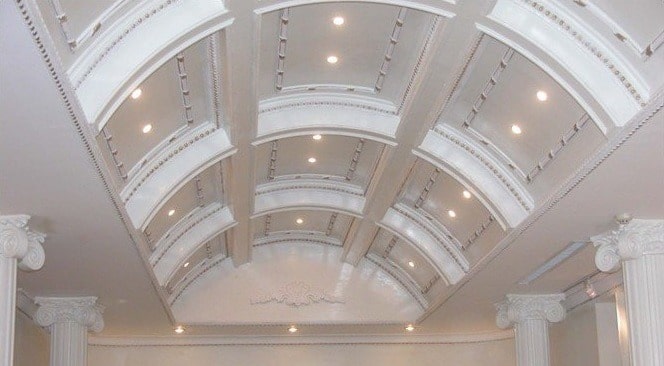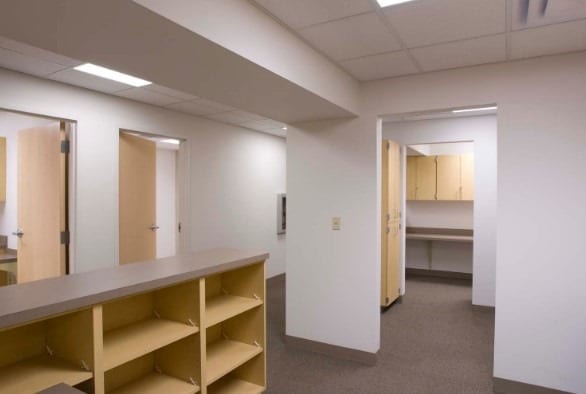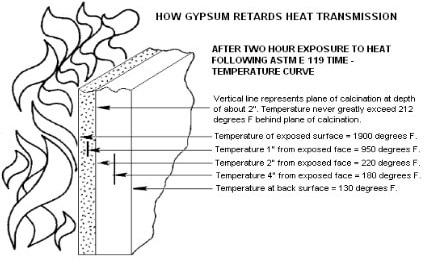
..................................................................................................................................................................
Gypsum As Construction Material
 |
| Gypsum Wall Panels and Ceilings Used for Office Interior |
Gypsum Products and Properties as a Building Material for
Construction
Neenu Arjun
Gypsum
is one of the widely used construction material mainly in interior designing.
Properties
and products of gypsum to be used as building material in construction works
are discussed.
Gypsum
is used as surface material. Its application is prominent in wall and ceiling
construction. The use of gypsum can also be done at the field in the form of
plaster.
It
is also manufactured as a prefabricated unit, like gypsum board which is bought
at the time of installation.
Production
of Gypsum for use in Construction Works
Gypsum
is a white to gray mineral found in the earth’s crust.
It
is chemically known as hydrous calcium sulfate (CaSO4.2H2O) which are obtained
through mining from vast veins. It’s in different forms. It is seen as sand in
certain areas.
The
gypsum stone, which is called alabaster has the property to be carved to any
sculpture forms. This stone is translucent in nature.
It
consists of around 30% of bounded water in natural state. Water is taken out
from it through continuous heating till its white powder form is obtained.
Process
of Gypsum Production
The production of gypsum can be mentioned in following stages:
Excavation
Crushing
Grinding
Calcination
Cooling
and Pulverizing
Packing
 |
| Gypsum Production Layout |
They
are also seen deposited in the sea water or lake. Then it is crushed into
particles of size approximately 25mm and subjected to grinding.
The
next main stage in its production is heating of the ground material, it is also
called as calcination.
Here
its particles are heated to 100 to 190-degree Celsius which result in three
forth of water loss from the particle.
This
process is called as the incomplete calcination or low burning process. Which
can be represented by the chemical equation:
CaSO4.2H2O
= CaSO4.1/2 H2O + 3/2 H2O
CaSO4.1/2
H2O = Plaster of Paris
The
temperature is further increased above 190 degrees Celsius which forms high
burning process or complete calcination:
CaSO4.2H2O
= CaSO4 +2H2O
CaSO4
= Gypsum-Anhydrite
For
the manufacture of drywall and plaster material the mined gypsum is used as the
raw material.
Synthetic
gypsum is used in more amount for manufacture.
The
wet limestone which is a combination of calcium and water, when combined with
sulfate forming calcium sulfate or gypsum is called as a chemical gypsum or
synthetic gypsum.
Why
use Gypsum in Construction Works?
The
ability of gypsum to give a comfortable and aesthetic ambiance as a
construction material increase the demands of gypsum.
It
is nature’s product that is commonly available. It is free of odor.
Nowadays
many of the interior and the exterior construction features are mostly governed
by gypsum construction or gypsum products.
The
advancement of gypsum construction in a continuous process is due to its
reduced time and cost of construction.
With
time, gypsum products gain increasing properties like increased fire
resistance, acoustic properties for noise insulation, etc..
Properties
of Gypsum as a Building Material
The
properties that are inbuilt in gypsum that facilitates its huge demand in
construction are explained in this section.
The
main properties of gypsum products are:
Fire
Resistance of Gypsum
 |
Fire Resistance Behavior of Gypsum
|
Say
a gypsum plaster board of 15mm thickness would possess almost 3 liters of
crystal water within
it.
it.
When
fire approaches the water, it undergoes evaporation resulting in a protective
layer covering the gypsum product. This would help in stopping the spread of
fire to further materials.
Non-Combustible
Property of Gypsum
As
explained the heating up of gypsum products results in heating up of water
crystals present in the gypsum material.
This
dehydration of gypsum by heat is called as calcination.
The
calcination results in a covering over the materials that stop it to undergo
combustion and allow the material near them to maintain a lower safer
temperature.
Even
after complete calcination of water crystals, the residue would behave like an
insulating layer till it gets separated.
Gypsum
is considered as a good fire retarder because of its noncombustible property
and its capability to delay the spreading of fire for hours depending upon what
extend the gypsum products are used.
Acoustic
Properties of Gypsum
Gypsum
products are developed to focus more on sound insulation properties.
Other
methods like masonry would act good, which is commonly used in a higher
thickness that now is found less demanding compared to gypsum.
Gypsum
plasterboard is specially designed for noise reduction and prevent
reverberation. Incorporating an air space between two solid gypsum walls bring
higher acoustic performances, by restricting the noise to pass through.
For
example, instead of a masonry wall of 110mm thickness, we can install a drywall
of 75mm thickness to achieve same sound performance.
Thermal
Properties of Gypsum
The
thermal properties rendered by the gypsum construction would enable good
balancing of indoor humidity and temperature.
Gypsum
construction incorporating cavities, like plasterboard or formwork construction
with gypsum gives extra insulation properties.
Use
of plaster boards in interior construction acts as a vapor barrier preventing
indoor humidity.
Types
of Gypsum Products and their Uses
- Gypsum
Plaster Boards –Plasterboard are
panels used as partitions and for the lining of walls and the ceilings.
- Used
for Plaster for Decoration – The
combination of gypsum powder with water makes gypsum plaster that support
the formation of beautiful aesthetically pleasing linings for ceilings or
wall. They help in molding as well as shaping.
- Used
for walls and ceiling
- Gypsum
plaster Blocks used as partitions and as tiles
- Used
for self-leveling screeds
- Fiberboard
with Gypsum
Advantages
of Gypsum as a Building Material
A
set of outstanding advantages is shown by gypsum as a construction material.
Some of the main advantages are mentioned below:
· Delivers
Smooth Surface – It is used
as a plaster material if properly done would provide us with a smooth white
finish, which is free of cracks as well as scars. This is a highlighting
property when it comes to indoor finishing.
· Balance
Indoor Atmosphere – It is of
natural origin. They have a natural capability of balancing the indoor climate
as well as humidity.
· It
is environmental friendly
· It
is fire resistant in nature
· It
has high thermal and acoustic insulation
· It
provides good aesthetic and functional features – The creativity of architects is boosted by the
incorporation of gypsum products, within the budget. It provides a variety of
stunning design options.
· Ease of
Installation – Using
gypsum products, for example, for an internal wall construction, we just need
to fix the frame and fill up the joints. The full process is clean, easy and
fast. Using gypsum plaster as a final finish reduces the work of additional
painting. The white finish itself give a clean appearance.
· Variety
of Gypsum Products – A large variety of gypsum products is available that meets several
practical and aesthetic requirements. The choice of the right product is made
with the help of unique packages that is given by the manufacturers with
adequate technical assistance.
Neenu Arjun is a Civil and Structural Engineer and has experience
in Design of Concrete and Steel Structures. She is an Author, Editor and
Partner at theconstructor.org.

I read that Post and got it fine and informative. Commercial Kitchen
ReplyDeleteI have bookmarked your blog, the articles are way better than other similar blogs.. thanks for a great blog! https://westasianetwork.com/ashford-formula-dubai.php
ReplyDelete